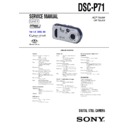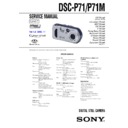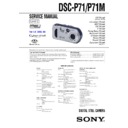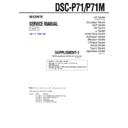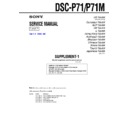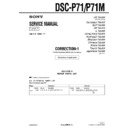Sony DSC-P71 Service Manual ▷ View online
SERVICE MANUAL
DIGITAL STILL CAMERA
AEP Model
UK Model
Level 1
SPECIFICATIONS
Ver 1.0 2002. 03
DSC-P71
System
Image device 8.93mm (1/1.8 type) color
CCD
Primary color filter
Primary color filter
Effective pixels number of camera
Approx. 3 210 000 pixels
Lens
3
× zoom lens
f=8~24.0 mm (35 mm camera
conversion: 39 to 117mm)
F2.8~5.3
conversion: 39 to 117mm)
F2.8~5.3
Exposure control
Automatic,
Scene Selection (3 mode)
Scene Selection (3 mode)
White balanceAutomatic, Daylight, Cloudy,
Fluorescent, Incandescent
Data formats Moving images: MPEG1
Still images: JPEG, GIFF (for Clip
Motion)
Motion)
Recording media
“Memory Stick”
Flash
Recommended distance
0.5 to 3.8 m (1.6 to 12.5 ft) (W)
0.5 to 2.5 m (1.6 to 8.2 ft) (T)
(when ISO sensitivity is set to Auto)
0.5 to 3.8 m (1.6 to 12.5 ft) (W)
0.5 to 2.5 m (1.6 to 8.2 ft) (T)
(when ISO sensitivity is set to Auto)
Output connectors
VIDEO OUT jack
Minijack
1 Vp-p, 75 ohm, unbalanced, sync
negative
1 Vp-p, 75 ohm, unbalanced, sync
negative
USB jack
mini-B
LCD screen
LCD panel used
3.8 cm (1.5 type) TFT drive
Total number of dots
123 200 (560x220) dots
Power, etc.
Power AA nickel hydride
batteries
(2)
2.4 V
AC-LS1 AC power adaptor
(not supplied), 4.2 V
AC-LS1 AC power adaptor
(not supplied), 4.2 V
Power consumption (when recording)
2.1W
Operating temperature range
0
° to
+
40
°C (32° to
+
104
°F)
Storage temperature range
−
20
° to
+
60
°C (
−
4
° to
+
140
°F)
Dimensions
124.9
× 58 × 43.6 mm (5 × 2
3
/
8
1
3
/
4
inches)
(W/H/D, protruding portions not
included)
included)
Mass
284 g (10 oz) (camera, two batteries,
“Memory Stick” and wrist strap
included)
“Memory Stick” and wrist strap
included)
BC-CS1 Ni-MH battery charger
Power requirements
AC 100 to 240V 50/60Hz
2.2 W
2.2 W
Output voltage
DC 1.8V 180/110 mA
2
Dimensions
70
× 29 × 74 mm (2
7
/
8
× 1
3
/
16
× 3
inches) (W/H/D)
Mass
Approx. 70g (2 oz)
Operating temperature range
0
° to +40°C (32° to +104°F)
AC-LS1 AC power adaptor (not
supplied)
supplied)
Power requirements
AC 100 – 240 V, 50/60 Hz
Rated output voltage
DC 4.2 V, 1.5 A
External dimensions
105
× 36 × 56 mm (4
1
/
4
×
×
1
7
/
16
2
1
/
4
) (W/H/D, protruding parts not
included)
Mass
Approx. 180 g (6 oz)
(adaptor only)
(adaptor only)
Operating temperature range
0
° to
+
40
°C (32° to
+
104
°F)
Storage temperature range
−
20
° to
+
60
°C (
−
4
° to
+
140
°F)
Accessories
• Video connector cable (1)
• R6 (size AA) Ni-MH batteries (2)
• Ni-MH Battery charger (1)
• Power cord (mains lead) (1)
• USB cable (1)
• Wrist strap
• “Memory Stick” (16MB) (1)
• CD-ROM (USB driver: SPVD-008) (1)
• CD-ROM (for Customer registration) (1)
• Operation Instructions (1)
• R6 (size AA) Ni-MH batteries (2)
• Ni-MH Battery charger (1)
• Power cord (mains lead) (1)
• USB cable (1)
• Wrist strap
• “Memory Stick” (16MB) (1)
• CD-ROM (USB driver: SPVD-008) (1)
• CD-ROM (for Customer registration) (1)
• Operation Instructions (1)
Design and specifications are subject to change
without notice.
without notice.
×
– 2 –
DSC-P71
1. Check the area of your repair for unsoldered or poorly-sol-
dered connections. Check the entire board surface for solder
splashes and bridges.
splashes and bridges.
2. Check the interboard wiring to ensure that no wires are
“pinched” or contact high-wattage resistors.
3. Look for unauthorized replacement parts, particularly transis-
tors, that were installed during a previous repair. Point them
out to the customer and recommend their replacement.
out to the customer and recommend their replacement.
SAFETY CHECK-OUT
After correcting the original service problem, perform the following
safety checks before releasing the set to the customer.
safety checks before releasing the set to the customer.
SAFETY-RELATED COMPONENT WARNING!!
COMPONENTS IDENTIFIED BY MARK
0
OR DOTTED
LINE WITH MARK
0
ON THE SCHEMATIC DIAGRAMS
AND IN THE PARTS LIST ARE CRITICAL TO SAFE
OPERATION. REPLACE THESE COMPONENTS WITH
SONY PARTS WHOSE PART NUMBERS APPEAR AS
SHOWN IN THIS MANUAL OR IN SUPPLEMENTS PUB-
LISHED BY SONY.
OPERATION. REPLACE THESE COMPONENTS WITH
SONY PARTS WHOSE PART NUMBERS APPEAR AS
SHOWN IN THIS MANUAL OR IN SUPPLEMENTS PUB-
LISHED BY SONY.
4. Look for parts which, though functioning, show obvious signs
of deterioration. Point them out to the customer and recom-
mend their replacement.
mend their replacement.
5. Check the B+ voltage to see it is at the values specified.
6. Flexible Circuit Board Repairing
•
Keep the temperature of the soldering iron around 270 ˚C
during repairing.
during repairing.
•
Do not touch the soldering iron on the same conductor of
the circuit board (within 3 times).
the circuit board (within 3 times).
•
Be careful not to apply force on the conductor when sol-
dering or unsoldering.
dering or unsoldering.
– 3 –
DSC-P71
SERVICE NOTE
................................................................... 4
Self-diagnosis Display .......................................................... 5
1.
MAIN PARTS
1.
Ornamental parts .......................................................... 6
2.
DISASSEMBLY
2-1.
Cabinet (Rear) Block Assembly .................................... 8
2-2.
PK-064 Board ................................................................ 8
2-3.
LCD Module ................................................................... 9
2-4.
Cabinet (Front) Block Assembly .................................... 9
2-5.
Cabinet (Upper) Block Assembly .................................. 10
2-6.
ST-075 Board ................................................................. 10
2-7.
Lens Block Assembly .................................................... 11
2-8.
Memory Stick Connector ............................................... 11
2-9.
JK-231 Board ................................................................ 12
2-11. SY-075 Board ................................................................ 12
3.
REPAIR PARTS LIST
3-1.
Exploded Views ............................................................. 13
3-1-1. Cabinet (Front) Section ............................................ 13
3-1-2. Cabinet (Rear) Assembly ......................................... 14
3-1-3. Lens Block Assembly ............................................... 15
3-1-2. Cabinet (Rear) Assembly ......................................... 14
3-1-3. Lens Block Assembly ............................................... 15
4.
GENERAL
Before using your camera ....................................................... 17
Identifying the Parts ................................................................. 19
Preparing batteries .................................................................. 20
Charging the batteries ............................................................. 20
Inserting the batteries ............................................................. 21
Using an external power source ............................................. 22
Using your camera abroad ...................................................... 22
Turning on/off your camera ..................................................... 23
How to use the control button ................................................. 23
Setting the data and time ........................................................ 23
Inserting and removing a “Memory Stick” ............................... 24
Deciding the still image size and image quality ...................... 25
Basic still image shooting (using auto adjustment mode) ...... 26
Viewing images on the LCD screen of your camera .............. 31
Viewing images on a TV screen .............................................. 32
Deleting still images ................................................................ 32
Formatting a “Memory Stick” ................................................... 34
Copying still images to your Computer ................................... 35
Installing the USB driver .......................................................... 35
Preparing your camera ............................................................ 36
Connecting your camera to your computer ............................. 36
Copying images ....................................................................... 37
Viewing the images on your computer .................................... 39
For Macintosh users ................................................................ 40
How to setup and operate your camera .................................. 40
Troubleshooting ....................................................................... 54
Warning and Messages ........................................................... 57
Self-diagnostics Display .......................................................... 58
Menu items .............................................................................. 59
SET UP items .......................................................................... 61
The LCD screen ...................................................................... 63
Identifying the Parts ................................................................. 19
Preparing batteries .................................................................. 20
Charging the batteries ............................................................. 20
Inserting the batteries ............................................................. 21
Using an external power source ............................................. 22
Using your camera abroad ...................................................... 22
Turning on/off your camera ..................................................... 23
How to use the control button ................................................. 23
Setting the data and time ........................................................ 23
Inserting and removing a “Memory Stick” ............................... 24
Deciding the still image size and image quality ...................... 25
Basic still image shooting (using auto adjustment mode) ...... 26
Viewing images on the LCD screen of your camera .............. 31
Viewing images on a TV screen .............................................. 32
Deleting still images ................................................................ 32
Formatting a “Memory Stick” ................................................... 34
Copying still images to your Computer ................................... 35
Installing the USB driver .......................................................... 35
Preparing your camera ............................................................ 36
Connecting your camera to your computer ............................. 36
Copying images ....................................................................... 37
Viewing the images on your computer .................................... 39
For Macintosh users ................................................................ 40
How to setup and operate your camera .................................. 40
Troubleshooting ....................................................................... 54
Warning and Messages ........................................................... 57
Self-diagnostics Display .......................................................... 58
Menu items .............................................................................. 59
SET UP items .......................................................................... 61
The LCD screen ...................................................................... 63
TABLE OF CONTENTS
Section
Title
Page
– 4 –
DSC-P71
[Discharging of the ST-075 board’s charging capacitor
(C510)]
(C510)]
The charging capacitor (C510) of the ST-075 board is charged up
to the maximum 300 V potential.
There is a danger of electric shock by this high voltage when the
battery is handled by hand. The electric shock is caused by the
charged voltage which is kept without discharging when the main
power of the unit is simply turned off. Therefore, the remaining
voltage must be discharged as described below.
to the maximum 300 V potential.
There is a danger of electric shock by this high voltage when the
battery is handled by hand. The electric shock is caused by the
charged voltage which is kept without discharging when the main
power of the unit is simply turned off. Therefore, the remaining
voltage must be discharged as described below.
Preparing the Short Jig
To preparing the short jig, a small clip is attached to each end of a
resistor of 1 k
resistor of 1 k
Ω /1 W (1-215-869-11).
Wrap insulating tape fully around the leads of the resistor to pre-
vent electrical shock.
vent electrical shock.
1 k
Ω
/1 W
Wrap insulating tape.
Discharging the Capacitor
Short-circuit between the positive and the negative terminals of
charged capacitor with the short jig about 10 seconds.
charged capacitor with the short jig about 10 seconds.
SERVICE NOTE
•
NOTE FOR REPAIR
Make sure that the flat cable and flexible board are not cracked of
bent at the terminal.
Do not insert the cable insufficiently nor crookedly.
bent at the terminal.
Do not insert the cable insufficiently nor crookedly.
Cut and remove the part of gilt
which comes off at the point.
(Be careful or some
pieces of gilt may be left inside)
which comes off at the point.
(Be careful or some
pieces of gilt may be left inside)
When remove a connector, don’t pull at wire of connector.
It is possible that a wire is snapped.
It is possible that a wire is snapped.
When installing a connector, don’t press down at wire of connector.
It is possible that a wire is snapped.
It is possible that a wire is snapped.
R:1 k
Ω
/1 W
(Part code:
1-215-869-11)
1-215-869-11)
Capacitor

